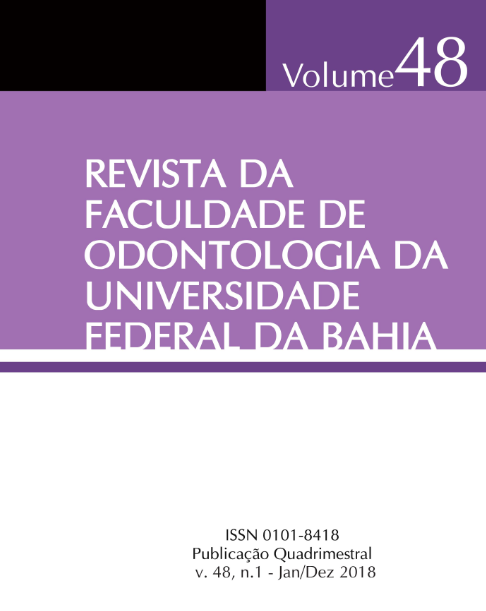ELETROMIOGRAFIA E CINESIOGRAFIA COMO MÉTODOS MENSURATIVOS EM DIAGNÓSTICO E TRATAMENTO DAS DISFUNÇÕES DA ARTICULAÇÃO TEMPOROMANDIBULAR ELECTROMYOGRAPHY AND KINESIOGRAPHY AS MENSURATIVE METHODS ON DIAGNOSIS AND TREATMENT OF TEMPOROMANDIBULAR JOINT DINFUNCTI
DOI:
https://doi.org/10.9771/revfo.v48i1.35818Palavras-chave:
Eletromiografia, Cinesiografia, Transtornos da articulação temporomandibular, Electromyography, Kinesiograph, Temporomandibular Joint DisordersResumo
O diagnóstico e manejo das disfunções temporomandibulares (DTM)
são um verdadeiro desafio ao cirurgião-dentista, devido a sua complexidade
anátomo-funcional, etiologia multifatorial e a falta de um
método mensurativo da presença e severidade das DTM, que possam
ser utilizados irrestritamente por pesquisadores e clínicos. A Eletromiografia
(EMG) e Cinesiografia (CSG) permitem a aquisição de dados
quantitativos, válidos, e podem ser utilizados como instrumentos no
diagnóstico e acompanhamento clínico de pacientes com DTM, além
de auxiliar na avaliação de resultados das modalidades de tratamento
aplicadas. Embora esta tecnologia esteja disponível desde a década
de 80, ainda é raro o número de estudos na odontologia utilizando
instrumentos de coleta de dados mensurativos, como estes ora disponíveis.
O objetivo deste trabalho é situar, por meio de uma revisão de
literatura, o estágio atual da EMG e a CSG na Odontologia, especialmente
no diagnóstico e acompanhamento dos tratamentos instituídos
nas enfermidades da ATM. Considerações Finais: A eletromiografia e
a cinesiografia são métodos auxiliares, quantitativos, válidos no diagnóstico
e no acompanhamento do tratamento das patologias de ATM;
A falta de padronização no diagnóstico e mensuração da severidade
das disfunções temporomandibulares dificulta o próprio diagnóstico
em DTMs subclínicas e a comparação entre os resultados das diferentes
terapêuticas; Alto custo e falta de treinamento adequado estão
entre as causas da baixa difusão destes métodos entre os cirurgiões-
-dentistas.
ABSTRACT
The diagnosis and management of temporomandibular disorders
(TMD) are a real challenge to the dentist because of its anatomical and
functional complexity, multifactorial etiology and the lack of a mensurative
of presence and severity of TMD, which can be used unrestrictedly
by researchers and clinicians. The electromyography (EMG) and
Kinesiography (KSG) allow the acquisition of valids quantitative data,
and can be used as tools in the diagnosis and clinical management of
patients with TMD, also assist in the evaluation of results on applied
treatment modalities. Although this technology is available from the
80s, is still rare the number of studies in dentistry using mensurative
data collection instruments, as these now available. The objective of
this paper is to stablish, through a literature review, the current stage
of EMG and the KSG in dentistry, especially in the diagnosis and monitoring
of treatments introduced in diseases of the TMJ. Electromyography
and kinesiography are auxiliary methods, quantitative, valid in the
diagnosis and monitoring of treatment of TMJ disorders; The lack of
standardization in the diagnosis and measurement of severity of temporomandibular
disorders complicates the diagnosis itself in subclinical
TMD and to compare the results of different therapeutic; High cost
and lack of proper training are among the causes of the low diffusion
of these methods between dentists.
Downloads
Downloads
Publicado
Como Citar
Edição
Seção
Licença
Copyright (c) 2020 Revista da Faculdade de Odontologia da UFBA

Este trabalho está licenciado sob uma licença Creative Commons Attribution-NonCommercial 4.0 International License.

